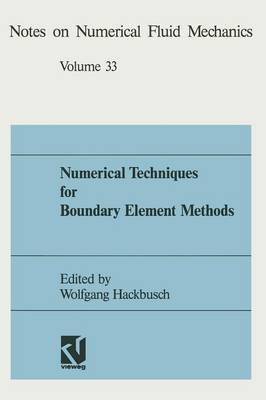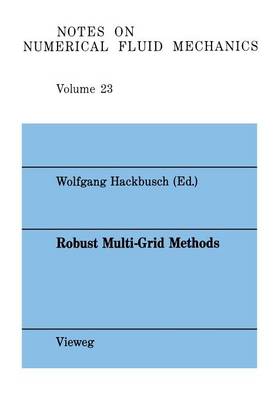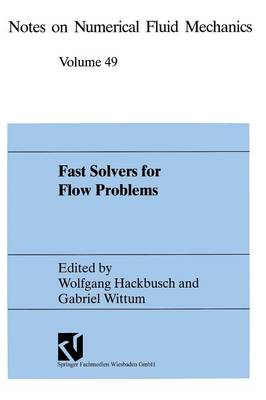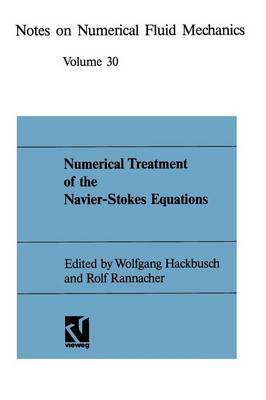Notes on Numerical Fluid Mechanics
4 total works
Vol 33
11 The GAMM Committee for Efficient Numerical Methods for Partial 11 Differential Equations organises workshops on subjects concerning the algorithmic treatment of partial differential equations. The topics are discretisation methods like the finite element and the boundary element method for various types of applications in structural and fluid mechanics. Particular attention is devoted to the advanced solution methods. The series of such workshops was continued in 1991, January 25- 27, with the 7th Kiel-Seminar on the special topic 11 11 Numerical techniques for boundary element methods at the Christian-Albrechts-University of Kiel. The seminar was attended by 57 scientists from 8 countries. The list of topics contained applications of the boundary element method (BEM) to various problems of practical interest, algo- rithmic aspects of the BEM (coupling with finite element method, parallelisation), convergence analysis, and in particular the treatment of the numerical integration. In six contributions the quadrature of weakly singular, Cauchy singular, and hypersingular integrals is analysed. 11 11 The editor thanks the DFG-Schwerpunkt Randelementmethoden for its support. He also likes to express his gratitude to all persons involved in the organisation of the seminar.
Vol 23
In full multigrid methods for elliptic difference equations one works on a sequence of meshes where a number of pre- and/or postsmoothing steps are performed on each level. As is well known these methods can converge very fast on problems with a smooth solution and a regular mesh, but the rate of convergence can be severely degraded for problems with unisotropy or discontinuous coefficients unless some form of robust smoother is used. Also problems can arise with the increasingly coarser meshes because for some types of discretization methods, coercivity may be lost on coarse meshes and on massively parallel computers the computation cost of transporting information between computer processors devoted to work on various levels of the mesh can dominate the whole computing time. For discussions about some of these problems, see (11). Here we propose a method that uses only two levels of meshes, the fine and the coarse level, respec- tively, and where the corrector on the coarse level is equal to a new type of preconditioner which uses an algebraic substructuring of the stiffness matrix. It is based on the block matrix tridiagonal structure one gets when the domain is subdivided into strips. This block-tridiagonal form is used to compute an approximate factorization whereby the Schur complements which arise in the recursive factorization are approximated in an indirect way, i. e.
v. 49
This volume contains 23 contributions to the 10th GAMM-Seminar, which was held in Kiel on the 14-16 of January 1994. The central topics are advanced numerical techniques for solving flow problems. The Navier-Stokes equations are discussed with respect to anisotropically refined meshes, in combination with non-equilibrium chemistry and with respect to implicit time-discretizations and parallel solvers. Furthermore, robust multi-grid methods are described for this problem. Five papers are devoted to parallel algorithms, and a further one to domain decomposition techniques. The very important aspect of adaptive strategies is considered in several contributions, including a discussion of appropriate error estimators. Other subjects are the FEM-BEM coupling, convection-dominated systems, unstructured grid techniques and complex geometries in 3-D.
Vol 30
Numerical Treatment of the Navier-Stokes Equations
by Wolfgang Hackbusch and Rolf Rannacher
Published 1 January 1990
The most frequently used method for the numerical integration of parabolic differential equa- tions is the method of lines, where one first uses a discretization of space derivatives by finite differences or finite elements and then uses some time-stepping method for the the solution of resulting system of ordinary differential equations. Such methods are, at least conceptually, easy to perform. However, they can be expensive if steep gradients occur in the solution, stability must be controlled, and the global error control can be troublesome. This paper considers a simultaneaus discretization of space and time variables for a one-dimensional parabolic equation on a relatively long time interval, called 'time-slab'. The discretization is repeated or adjusted for following 'time-slabs' using continuous finite element approximations. In such a method we utilize the efficiency of finite elements by choosing a finite element mesh in the time-space domain where the finite element mesh has been adjusted to steep gradients of the solution both with respect to the space and the time variables. In this way we solve all the difficulties with the classical approach since stability, discretization error estimates and global error control are automatically satisfied. Such a method has been discussed previously in [3] and [4]. The related boundary value techniques or global time integration for systems of ordinary differential equations have been discussed in several papers, see [12] and the references quoted therein.



